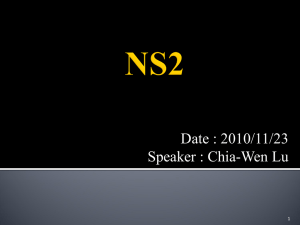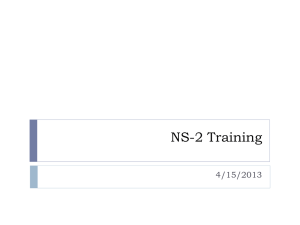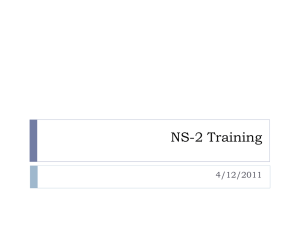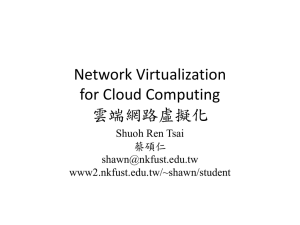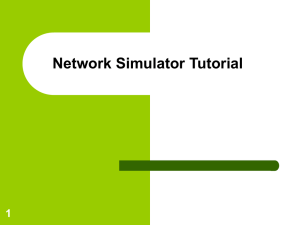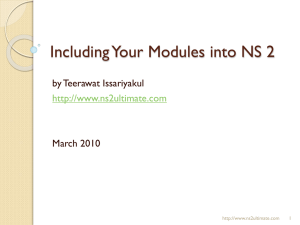NS2-slides.
advertisement
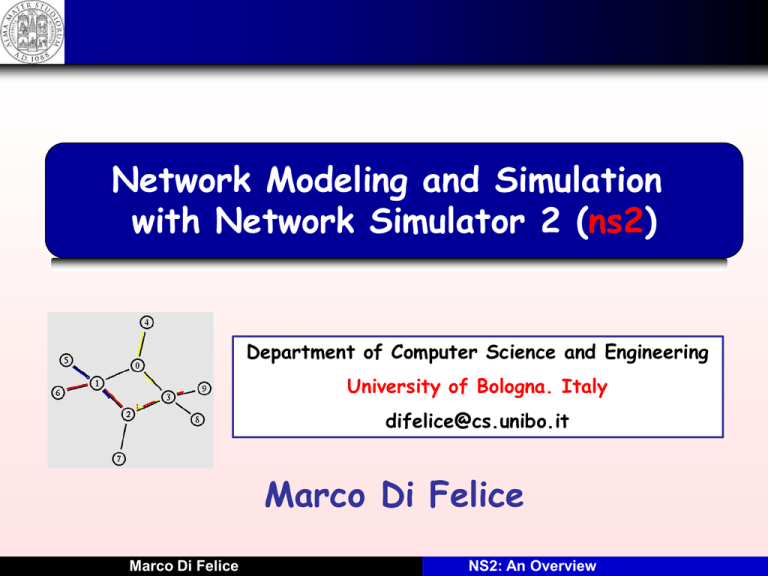
Network Modeling and Simulation
with Network Simulator 2 (ns2)
Department of Computer Science and Engineering
University of Bologna. Italy
difelice@cs.unibo.it
Marco Di Felice
Marco Di Felice
NS2: An Overview
Outline
NS2: Use Cases and Features
NS2: Architecture and Design
NS2: Building simple network models
NS2: Demo & Analysis
Marco Di Felice
NS2: An Overview
Ns2: An Overview
NS2: A (discrete event) network simulator tool.
Generally speaking, a network simulator is a
dedicated software that allows to:
Model the behaviour of network
protocols/applications (e.g. TCP protocol).
Reproduce the behaviour of a computer
network as a whole (e.g. a wireless LAN).
Quantify the network performance, through
well-defined network metrics (e.g. system
throughput).
Marco Di Felice
NS2: An Overview
Ns2: WHAT
Q. When may I use a network simulator?
Case 1: Network planning
Need to build a network
infrastructure, with coverage and
Quality of Service (QoS) issues.
Q1. Where to place the
network gateways?
Q2. How many gateways
do I really need?
Marco Di Felice
NS2: An Overview
Ns2: WHAT
Q. When may I use a network simulator?
Case 2: Network Evaluation
Need to evaluate the performance
of a (possibly large-scale) network
infrastructure or network application.
An example: Early Collision
Detection Systems In VANETs
Use an existing testbed BUT …
Q1. What is the cost of setting up
the experiments?
Q2. Are the experiments easily
reproducible?
Marco Di Felice
NS2: An Overview
Ns2: WHAT
Q. When may I use a network simulator?
Case 3: Research on Networking Systems
Need to evaluate the performance
of a new network protocol,
architecture, or application.
An example: Proposing a new
TCP variant for wireless LANs.
1. A real deployment might not be
feasible, or might be too costly.
2. Analytical models might be too
complex to model all the components
of the scenario under study.
Marco Di Felice
NS2: An Overview
Ns2: WHAT
Network simulators might be used to model
several kinds of networking systems (wired,
wireless, optical, etc).
In practice, simulation constitutes the main
evaluation technique for wireless systems.
Possibility to build reproducible experiments
(hard to guarantee with wireless testbeds).
Possibility to reproduce wireless propagation
phenomena in an accurate way through
probabilistic models (e.g. fading)
Possibility to model large-scale wireless
networks composed by several interacting
nodes.
Marco Di Felice
NS2: An Overview
Ns2: WHAT
Simulation is a meaningful evaluation approach
only when it produces “trustable” results.
Validation is needed to certify that the simulation
models reproduce correctly the characteristics
and dynamics of the system under study.
HOW to VALIDATE a NETWORK MODEL?
Compare Simulation vs Analytical Model
Compare Simulation vs Real Measurements
EXPERIMENTS
Marco Di Felice
SIM.
THROUGPUT
Q(1/ n× logn)
ANALYTICAL
NS2: An Overview
Ns2: WHAT
NS2: A network simulation tool
Discrete Event simulator (details later …)
NS2 allows to model and evaluate several IP
networking systems (LAN/WAN). It includes:
Network protocols model (e.g. MAC, routing, …)
Network applications model (e.g. CBR, FTP, …)
Queue management algorithms (e.g. FIFO, RED, …)
Network link models (e.g. lossy link)
…
Marco Di Felice
NS2: An Overview
Ns2: WHERE
http://www.isi.edu/nsnam/ns
http://sourceforge.net/projects/nsnam
download ns-allinone
includes several tools (ns2, nam, awk, otcl, …)
mailing list: ns-users@isi.edu
documentation:
Reference manual and Tutorials on the website
Other tutorials on the Web
Marco Di Felice
NS2: An Overview
Ns2: WHEN
The project started from REAL project in 1989
ns-1 by Floyd and McCanne at Lawrance Berkeley
National Laboratory (LBNL).
ns-2 by Steve McCanne, within the VINT project
involving a consortium of US universities (LBL, PARC,USC, ...)
currently maintained at USC/ISI (University of Southern
California), but several forks available.
NS3 relased in 2008 (now NS3.15)
Deployed by a team lead by Tom Henderson and Sally
Floyd (University of Washington)
A completely new tool, not a mere extension of Ns2 !
Marco Di Felice
NS2: An Overview
Ns2: WHY
NS2: A network simulation tool
Discrete Event simulator (details later …)
OTHER SIMULATION TOOLS
OMNET++
OPNET
JiST
NS3
GLOMOSIM
…
Q. WHY should I use NS2 for my research?
Marco Di Felice
NS2: An Overview
Ns2: WHY
NS2 includes a vast model library of network components.
Link Models:
Wired Links,
Wireless Links,
Satellite Links, …
Application Layer
FTP, Telnet, HTTP, Multimedia, Exponential traffic, …
Transport Layer
UDP, TCP (Reno, NewReno, Vegas, SACK), …
Network Layer
Wired routing (RIP), Ad Hoc Routing (AODV, OLSR, DSR), …
MAC Layer
Ethernet, 802.11 (WIFI), 802.15.4, Bluetooth, 802.16 (WIMAX), …
Marco Di Felice
NS2: An Overview
Ns2: WHY
NS2 is distributed with GNU General Public Licence (GPL)
Collaborative deployment environment
possibility to freely modify the existing NS2 code based
on each user’s needs.
possibility to share network models for
research/education purposes (e.g. a new implementation of
TCP).
possibility to compare his/her own model with models
implemented by other research teams.
Multi-platform support
GNU/Linux, MAC OSX, Solaris, Windows, …
Marco Di Felice
NS2: An Overview
Ns2: WHY
NS2 is a popular tool, widely adopted by researchers
working on the field of computer networks.
Number of Users: 10K
Institutes: 1K
% Papers: 44.4%
MOBIHOC Conference: Statistics on tools used to produce a simulation study
within the papers submitted at the ACM MOBIHOC conference (2000-2006).
Marco Di Felice
NS2: An Overview
Ns2: WHY
Q. WHY NOT to use NS2 for my research?
Monolithic (basic) scheduler,
scalability constitutes a big issue.
Architectural issues
Not really a modular architecture,
difficult to share the code of
network models.
Evaluation issues
No support for the trace analysis.
CPU time
Performance issues
?
#nodes
NS2
TRACE
Marco Di Felice
NS2: An Overview
NS2: HOW
Two programming languages: C++ and OTCL.
OTCL for simulation setup and execution
Quickly define the simulation environment
C++ for model deployment
Implement the behaviour of a network component
Marco Di Felice
NS2: An Overview
NS2: HOW
The core of the NS2 simulator is the Scheduler
Discrete-event scheduler.
Basic implementation, few optimization.
Event in NS2
ID TYPE TIME
Packet sent
Packet received
Packet dropped
Packet
Events
Timer
Events
HANDLER
NS2 Object
+ function name
that should be
invoked once the
event is fired.
Simulation time of the event
Marco Di Felice
NS2: An Overview
NS2: HOW
The Scheduler manages the simulation event list.
The elements are the events of the simulation.
The list is ordered on the basis of the time field.
SIMULATION
TIME:
TIME:
E1.time
t
E1 E2 E3 E4 E5 E6
At each simulation step:
1
TYPE
TIME
HANDLER
1. The head element of the list is removed
2. The simulation time is set to E1.time
3. The event handler (E1.handler) is executed.
Marco Di Felice
NS2: An Overview
NS2: HOW
The Scheduler manages the simulation event list.
The elements are the events of the simulation.
The list is ordered on the basis of the time field.
E2 E3 E4 E5 E6 E7
At each simulation step:
SIMULATION
TIME:
TIME:
E1.time
t
E1.HANDLER
E1.handler is executed, and it might generate
new events (e.g. E7), that are inserted into the
event list (at a position denoted by E7.time)
Marco Di Felice
NS2: An Overview
NS2: HOW
Let’s make an example on a network scenario …
NODE A
NODE B
APPLICATION
MAC
APPLICATION
MAC
ETHERNET
LINK
SIMULATION
TIME: 0
EVENT LIST
At t=0, the Application module of node A is invoked
Marco Di Felice
NS2: An Overview
NS2: HOW
Let’s make an example on a network scenario …
NODE A
NODE B
APPLICATION
APPLICATION
MAC
MAC
ETHERNET
LINK
SIMULATION
TIME: 0
E1
EVENT LIST
1
Send
4
A.APPLICATION
A timer event is scheduled at time 4 by node A
Marco Di Felice
NS2: An Overview
NS2: HOW
Let’s make an example on a network scenario …
NODE A
NODE B
APPLICATION
APPLICATION
MAC
MAC
ETHERNET
LINK
SIMULATION
TIME: 4
E2 E3
EVENT LIST
Marco Di Felice
2
Recv
4.5
A.MAC
3
Send
8
A.APPLICATION
NS2: An Overview
NS2: HOW
Let’s make an example on a network scenario …
NODE A
NODE B
APPLICATION
APPLICATION
MAC
MAC
ETHERNET
LINK
SIMULATION
TIME: 4.5
E4 E3
EVENT LIST
Marco Di Felice
4
Recv
5.0
B.MAC
3
Send
8
A.APPLICATION
NS2: An Overview
NS2: HOW
Let’s make an example on a network scenario …
NODE A
NODE B
APPLICATION
APPLICATION
MAC
MAC
ETHERNET
LINK
SIMULATION
TIME: 5
E5 E3
EVENT LIST
Marco Di Felice
5
Recv
5.2
B.APPLICATION
3
Send
8
A.APPLICATION
NS2: An Overview
NS2: HOW
Let’s make an example on a network scenario …
NODE A
NODE B
APPLICATION
APPLICATION
MAC
MAC
ETHERNET
LINK
SIMULATION
TIME: 5.2
E3
EVENT LIST
3
Send
8
A.APPLICATION
The message is processed by Node B at time 5.2
Marco Di Felice
NS2: An Overview
Ns2: HOW
Two ways of interactions:
Modify/Create a new network model
NOT EASY
- Network models: network protocols, applications, queue policies,
network architecture models, etc.
- Coding in C++
- Recompile at the end.
Configure/Run a network simulation
QUITE EASY
- Coding in OTCL
- Executed by an interpreter, no need to recompile.
Marco Di Felice
NS2: An Overview
Ns2: HOW
Running an OTCL script:
ns script-file.tcl [parameters]
Initialize the scheduler
Define the simulation parameters (e.g. start time)
Build the network topology
Generate the traffic load
Define the protocol stack used by each node
OTCL scripting language, OO-extension of TCL
Marco Di Felice
NS2: An Overview
Ns2: OTCL inside
Assign a value to a variable
OTCL Overview
set x 0
Keyword $ returns the value of a variable
set y $x
Selection Statements if (if < expr > ... else ...)
if
{$x == $y }
{ puts “Hello world” }
Iterative Statements
for
{set i 0; $i < $x ; incr i}{puts “Hello world” }
Function Declaration
proc
name_FUNCTION
Marco Di Felice
{par1, ...parn} {... return $x}
NS2: An Overview
Ns2: HOW
Running an OTCL script:
ns script-file.tcl [parameters]
Initialize the scheduler
Define the simulation parameters (e.g. start time)
Build the network topology
Generate the traffic load
Define the protocol stack used by each node
OTCL scripting language, OO-extension of TCL
Marco Di Felice
NS2: An Overview
Ns2: Initialize the Scheduler
Creating the Event Scheduler
set ns [new Simulator]
Starting the simulation
$ns run
Initializing the random number generator
$ns-random SEED
Scheduling the events
$ns at <time> <event>
SEED=0 current timestamp
All the random variable used
by the current simulation are
initialized with this SEED.
Stopping the simulation at time 300
$ns at 300 "finish“
Marco Di Felice
NS2: An Overview
Ns2: HOW
Running an OTCL script:
ns script-file.tcl [parameters]
Initialize the scheduler
Define the simulation parameters (e.g. start time)
Build the network topology
Generate the traffic load
Define the protocol stack used by each node
OTCL scripting language, OO-extension of TCL
Marco Di Felice
NS2: An Overview
Ns2: Building the network
(WIRED)
CASE 1. Modeling a wired network.
Define the nodes of the network
set n0 [$ns node]
set n1 [$ns node]
Define the Links among nodes
#Nodes connected with an Ethernet cable, 10 Mb/s
$ns duplex-link $n0 $n1 10Mb 100ms DropTail
Specifies bandwidth, delay, and queue policy:
DropTail, RED, CBQ, FQ, SFQ, DRR
Marco Di Felice
NS2: An Overview
Ns2: Building the network
(WIRED)
CASE 1. Modeling a wired network.
Define the error model on wired links
set loss_module [new ErrorModel]
$loss_module set rate_ 0.1
$loss_module ranvar [new RandomVariable/Uniform]
$loss_module drop-target [new Agent/Null]
$ns lossmodel $loss_module $n0 $n1
Lossy link between node 0 and node 1, with
error rate equal to 0.1. Packets with errors are sent
to Agent/Null, i.e. they are discarded.
Marco Di Felice
NS2: An Overview
Ns2: Building the network
(WIRED)
CASE 1. Modeling a wireless network.
Define the nodes of the network
set n0 [$ns node]
set n1 [$ns node]
Define the position
set topograpy [new Topography]
$topography load_flatgrid 400 400
Set simulation area
to 400mx400m
Define the position
$n0 set X_ 300
$n0 set Y_ 400
$n0 set Z_ 0
Marco Di Felice
Set node 0 at position <300,400,0>
NS2: An Overview
Ns2: Building the network
(WIRED)
CASE 1. Modeling a wireless network.
Define the mobility of wireless nodes
NS_OBJ at TIME “NODE setdest X_COOR Y_COOR SPEED”
$ns at 10.5 “$node(0) setdest 100 100 5.0”
At time 10.5, node 0 will move toward
position (100,100) with speed equal to
5 m/s (constant speed)
Utilize the General Object Director (GOD)
set $god [new God]
Marco Di Felice
Object that stores global information
about the state of the environment (e.g.
the matrix of connectivity among nodes)
NS2: An Overview
Ns2: Building the network
(WIRED)
CASE 1. Modeling a wireless network.
The mobility traces of wireless nodes can be pregenerated by using the setdest tool (random waypoint model)
./setdest [-n num_of_nodes] [-p pausetime] [maxspeed]
[-t simtime] [-x][-y] > [fileOutput]
In the TCL script:
source “fileOutput”
Any mobility simulator can be used for trace generation.
MOBILITY
SIMULATOR
e.g. SUMO
Marco Di Felice
OTCL
SCRIPT
MOB.
TRACE
SOURCE
NS2: An Overview
NS2
Ns2: HOW
Running an OTCL script:
ns script-file.tcl [parameters]
Initialize the scheduler
Define the simulation parameters (e.g. start time)
Build the network topology
Generate the traffic load
Define the protocol stack used by each node
OTCL scripting language, OO-extension of TCL
Marco Di Felice
NS2: An Overview
Ns2: Creating connections
(UDP/TCP)
Define the end-points of the communication
TCP Connections:
Several TCP variants:
set src [new Agent/TCP]
set dst [new Agent/TCPSink]
UDP Connections:
set src [new Agent/UDP]
set dst [new Agent/Null]
TCP Tahoe
TCP Reno
TCP NewReno
TCP Vegas
TCP SACK
…
Connect sender and receiver
$ns attach-agent $n0 $src
$ns attach-agent $n1 $dst
$ns connect $src $dst
Marco Di Felice
NS2: An Overview
Ns2: Attaching Applications
Define the application and attach it to the sender
FTP Agent
set ftp [new Application/FTP]
$ftp attach-agent $src
$ns at TIME “$ftp start”
CBR Agent
set cbr [new Application/Traffic/CBR]
$cbr attach-agent $src
$ns at TIME “$cbr start”
Exponential Traffic Generator
set exp [new Application/Traffic/Exponential]
Marco Di Felice
NS2: An Overview
Ns2: HOW
Running an OTCL script:
ns script-file.tcl [parameters]
Initialize the scheduler
Define the simulation parameters (e.g. start time)
Build the network topology
Generate the traffic load
Define the protocol stack used by each node
OTCL scripting language, OO-extension of TCL
Marco Di Felice
NS2: An Overview
Ns2: HOW
A wireless environment can be modeled by
configuring the protocol stack of each node.
$ns_ node-config –phyType $val(netif)
-propType $val(prop)
NET LAYER
-antType $val(type)
-llType $val(ll)
QUEUE
-macType $val(mac)
LL LAYER
-ifqType $val(ifq)
-ifqLen $val(ifqlen)
-adhocRouting $val(rp)
MAC LAYER
-topoInstance $topo
ANTENNA PROPAGATION
-channel $chan_
PHY LAYER
Marco Di Felice
NS2: An Overview
Ns2: HOW
A wireless environment can be modeled by
configuring the protocol stack of each node.
$ns_ node-config –phyType $val(netif)
-propType $val(prop)
NET LAYER
-antType $val(type)
-llType $val(ll)
QUEUE
-macType $val(mac)
LL LAYER
-ifqType $val(ifq)
-ifqLen $val(ifqlen)
-adhocRouting $val(rp)
MAC LAYER
-topoInstance $topo
ANTENNA PROPAGATION
-channel $chan_
PHY LAYER
Marco Di Felice
NS2: An Overview
Ns2: HOW
Configuring the PHY Layer
set val(netif) Phy/WirelessPhy[Ext]
Some parameters to be tuned:
Phy/WirelessPhy set Pt 2.07983391e-01
Phy/WirelessPhy set RXThresh 2.591168e-08
Phy/WirelessPhy set CSThresh 3.497734e-09
Functionalities offered by the PHY Layers
Signal capture
Modulation & Bit-rate setting
Modeling of collision/transmission errors
…
Marco Di Felice
NS2: An Overview
Ns2: HOW
A wireless environment can be modeled by
configuring the protocol stack of each node.
$ns_ node-config –phyType $val(netif)
-propType $val(prop)
NET LAYER
-antType $val(type)
-llType $val(ll)
QUEUE
-macType $val(mac)
LL LAYER
-ifqType $val(ifq)
-ifqLen $val(ifqlen)
-adhocRouting $val(rp)
MAC LAYER
-topoInstance $topo
ANTENNA PROPAGATION
-channel $chan_
PHY LAYER
Marco Di Felice
NS2: An Overview
Ns2: HOW
Configuring the Propagation model
set val(prop) Propagation/TwoRayGround
set val(prop) Propagation/FreeSpace
FREE SPACE
TWORAY
RECEIVER
SENDER
Configuring the Antenna model
set val(antType) Antenna/OmniAntenna
set val(antType) Antenna/Directional
DIRECTIONAL
Marco Di Felice
OMNIDIRECTIONAL
NS2: An Overview
Ns2: HOW
A wireless environment can be modeled by
configuring the protocol stack of each node.
$ns_ node-config –phyType $val(netif)
-propType $val(prop)
NET LAYER
-antType $val(type)
-llType $val(ll)
QUEUE
-macType $val(mac)
LL LAYER
-ifqType $val(ifq)
-ifqLen $val(ifqlen)
-adhocRouting $val(rp)
MAC LAYER
-topoInstance $topo
ANTENNA PROPAGATION
-channel $chan
PHY LAYER
Marco Di Felice
NS2: An Overview
Ns2: HOW
Configuring the LL layer
set val(ll) LL
Include ARP protocol
Configuring the MAC model
set val(mac) Mac/802_11
Configuring the Queue Layer
Select a MAC protocol:
802.11 (Wifi)
802.15.4 (Sensors)
CSMA/CA
…
set val(ifq) Queue/DropTail/PrimaryQueue
set val(ifqlen) 50
Set the queue length
Marco Di Felice
Define the queue policy:
PrimaryQueue
RED Queue
…
NS2: An Overview
Ns2: HOW
A wireless environment can be modeled by
configuring the protocol stack of each node.
$ns_ node-config –phyType $val(netif)
-propType $val(prop)
NET LAYER
-antType $val(type)
-llType $val(ll)
QUEUE
-macType $val(mac)
LL LAYER
-ifqType $val(ifq)
-ifqLen $val(ifqlen)
-adhocRouting $val(rp)
MAC LAYER
-topoInstance $topo
ANTENNA PROPAGATION
-channel $chan
PHY LAYER
Marco Di Felice
NS2: An Overview
Ns2: HOW
Configuring the routing protocol
set val(adhocrouting) AODV
Select a routing protocol for multi-hop networks:
AODV, DSDV, DSR, TORA, ….
SOURCE
ROUTING PATH
Marco Di Felice
DESTINATION
NS2: An Overview
Ns2: HOW
Two ways of interactions:
Modify/Create a new network model
NOT EASY
- Network models: network protocols, applications, queue policies,
network architecture models, etc.
- Coding in C++
- Recompile at the end.
Configure/Run a network simulation
QUITE EASY
- Coding in OTCL
- Executed by an interpreter, no need to recompile.
Marco Di Felice
NS2: An Overview
Ns2: HOW
In C++, each model extends the class NSObject.
Each NSObject has a correspective in OTCL.
Marco Di Felice
NS2: An Overview
Ns2: HOW
When creating a new model in C++:
Extend the NSObject class
Create the corresponding OTCL class
Implement these methods
recv(Packet* p, Handler* h) Callback
once a packet is received from the upper layer.
command(int argc, const char*const*
argv) Binding between C++ and OTCL for the
parameter passing from the TCL script.
Marco Di Felice
NS2: An Overview
Ns2: Simulation Output
(TRACE)
The output of the simulation is a trace file,
containing the description of the events occurred
during the simulation.
s 10.00000 0 MAC --- 0 RTS 44 [253e 1 0 0]
r 10.00041 1 MAC --- 0 RTS 44 [253e 1 0 0]
s 10.00042 1 MAC --- 0 CTS 38 [2404 0 0 0]
r 10.00075 0 MAC --- 0 CTS 38 [2404 0 0 0]
s 10.00076 0 MAC --- 100 cbr 1112 [13a 1 0 800]
r 10.00982 1 MAC --- 100 cbr 1112 [13a 1 0 800]
Simulation
Time
Node
Packet
ID
Traffic
type
Packet
size
MAC Header
Event Type
Marco Di Felice
NS2: An Overview
Ns2: Simulation Output
(TRACE)
Depending on the length of the simulation, the
trace file might occupy lots of bytes on the disk.
$ns_ node-config –agentTrace ON/OFF
-routerTrace ON/OFF
-macTrace ON/OFF
-mobilityTrace ON/OFF
Configure the granularity of the tracing process …
s 10.00078 1 AGT --- 100 cbr 1112 [13a 1 0 800]
s 10.00078 1 MAC --- 100 cbr 1112 [13a 1 0 800]
r 10.00078 0 MAC --- 100 cbr 1112 [13a 1 0 800]
r 10.00078 0 AGT --- 100 cbr 1112 [13a 1 0 800]
Marco Di Felice
NS2: An Overview
Ns2: Simulation Output
(NAM)
The output of the simulation can be visualized by
using the Network Animator (NAM) tool.
Marco Di Felice
NS2: An Overview
Ns2: Analysis of Simulation Results
NS2 does NOT provide any specific support for
the data analysis/validation and for the computation
of performance metrics (e.g. throughput, delay).
Run multiple simulations with different seeds
Remove the transient phase from the trace file
Extract the performance metrics from the trace file
Compute the average and confidence intervals
Plot the results
GNUPLOT
AWK, PERL, …
External data processing tools must be used.
Marco Di Felice
NS2: An Overview
Ns2: Analysis of Simulation Results
Example: Computing the system throughput in AWK.
BEGIN {
recvByte=sim_time=transient=0.0
}
($1==‘r’) && ($4==‘AGT’) && ($2>transient) {
recvByte+=$8
sim_time=$2
}
END {
print recvByte/(sime_time-transient)
}
Marco Di Felice
NS2: An Overview
